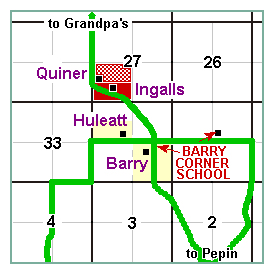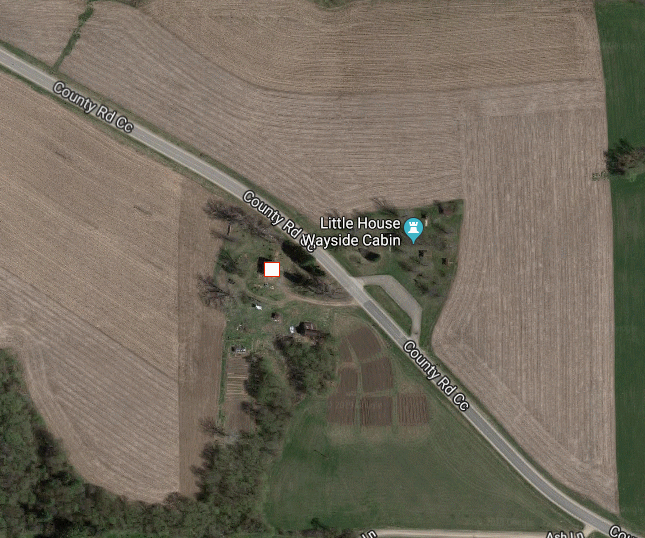Little House in the Big Woods – historical perspective

 The Ingalls and Quiner families in Pepin County. Both the Ingalls and Quiner families lived in Jefferson County, Wisconsin, prior to moving west to Pepin County and neighboring Pierce County. The motivation for such a move probably came from Lockwood neighbors and brothers Charles and Verdine Carpenter, who had taken farms in Pepin County prior to the Civil War. Verdine served in the 16th Wisconsin Infantry out of Pepin County and died in Louisiana in 1862. Charles Carpenter married Martha Quiner in 1860; her siblings Caroline, Henry, and Eliza – with their Ingalls spouses – soon followed the Carpenters to western Wisconsin. Charles Carpenter died in Stockholm, Pepin County in 1884, and he and his wife Martha are both buried in the cemetery north of Pepin.
The Ingalls and Quiner families in Pepin County. Both the Ingalls and Quiner families lived in Jefferson County, Wisconsin, prior to moving west to Pepin County and neighboring Pierce County. The motivation for such a move probably came from Lockwood neighbors and brothers Charles and Verdine Carpenter, who had taken farms in Pepin County prior to the Civil War. Verdine served in the 16th Wisconsin Infantry out of Pepin County and died in Louisiana in 1862. Charles Carpenter married Martha Quiner in 1860; her siblings Caroline, Henry, and Eliza – with their Ingalls spouses – soon followed the Carpenters to western Wisconsin. Charles Carpenter died in Stockholm, Pepin County in 1884, and he and his wife Martha are both buried in the cemetery north of Pepin.
After losing his farm in Jefferson County, Lansford Ingalls and son James (father and brother of Charles Ingalls) purchased land in Pepin County, but both soon moved north into Pierce County. No Ingallses or Quiners remained in Pepin County permanently, but James Ingalls did live in Pierce County until late in life.
 Charles Ingalls’ Land Dealings in Pepin County. In the fall of 1863, Charles Ingalls and his brother-in-law, Henry Quiner, paid $335 for 160 acres in Pepin Township, Pepin County, Wisconsin. The Ingallses settled on the south half of the property, the Quiners on the north. The path that went by the log cabin cut through Charles Ingalls’ 80 acres and is County Road CC today. Pierce County begins a half-mile to the north; the town of Pepin is 7 miles south on the north shore of Lake Pepin, a wide portion of the Mississippi River. Barry Corner School was originally on one of the corners at the crossroads on James Barry’s farm; this is the location of the schoolhouse when Mary and Laura went to school there. A brick schoolhouse was later built on the north side of the road about a half mile to the east of the crossroads. Neither schoolhouse is standing today.
Charles Ingalls’ Land Dealings in Pepin County. In the fall of 1863, Charles Ingalls and his brother-in-law, Henry Quiner, paid $335 for 160 acres in Pepin Township, Pepin County, Wisconsin. The Ingallses settled on the south half of the property, the Quiners on the north. The path that went by the log cabin cut through Charles Ingalls’ 80 acres and is County Road CC today. Pierce County begins a half-mile to the north; the town of Pepin is 7 miles south on the north shore of Lake Pepin, a wide portion of the Mississippi River. Barry Corner School was originally on one of the corners at the crossroads on James Barry’s farm; this is the location of the schoolhouse when Mary and Laura went to school there. A brick schoolhouse was later built on the north side of the road about a half mile to the east of the crossroads. Neither schoolhouse is standing today.
Mouse-over / hover over the image below to see a 1949 aerial photograph in place of the 2019 Google aerial view of the Pepin Wayside area (Charles Ingalls’ land) to see how it looked before the replica cabin and parking area was added. The red box is not the replica cabin; it outlines the roof of the farmhouse on the west side of County Road CC, which is in both aerials. The replica cabin is beneath the word “Cabin” on the Google image.
In May 1868 – when Laura was a year old – Charles Ingalls sold his land to Gustaf Gustafson for about $1000. The Ingalls family moved in with Grandma and Grandpa Ingalls temporarily. After a while, they headed south to Missouri and then to Indian Territory, providing the setting and adventures described by Laura Ingalls Wilder in Little House on the Prairie.
In 1869, Charles Ingalls heard from Gustafson, who wanted Ingalls to take back the Wisconsin property which he could no longer pay for. By the end of May 1871, the Ingalls family had moved back to their little log cabin in the Big Woods. Henry Quiner’s family may have followed the Ingallses in 1868 – as they had also purchased land in Chariton County – but as there was only a narrow window of time in which the Quiners could have left/returned to Pepin, it’s likely that they didn’t travel with the Ingallses at all.
In October 1873, Charles Ingalls sold his Pepin land to Andrew Anderson for $1000, and according to Wilder’s unpublished Pioneer Girl manuscript, the family then went to live with Uncle Peter Ingalls’ family (Pa’s brother who was married to Ma’s sister) north of Pepin in Pierce County. In the early spring of 1874, the two families crossed Lake Pepin to Lake City, in Wabasha County, Minnesota. Uncle Peter’s family settled just south of the Zumbro River, but Laura’s family continued west.
The Town of Pepin. The Ingalls family lived in Pepin County from 1863-1868 and 1871-1874. The area around the town of Pepin had been settled in the late 1840s but the village itself wasn’t platted until 1856. The town prospered, surrounded by fertile farmland and due to its proximity to Lake Pepin and the area’s lumber industry. In the late 1850s, the village boasted hotels, stores, a post office, blacksmith shop, two banks, a church, a newspaper office, and a schoolhouse. Pioneers predicted that Pepin would continue to prosper, but the town had no adequate steamboat landing, and during times of low water, it was practically impossible to land either passengers or freight.
Laura Ingalls lived in Pepin Township during slow growth years. The year Laura was born, the county seat was moved from Pepin to Durand, and much of the county’s growth was centered there for the next decade. This probably suited Charles Ingalls just fine.
The Big Woods of Wisconsin. According to area newspapers at the time Little House in the Big Woods took place, the “Big Woods” was an informal term used to describe the heavily forested area of northwest Wisconsin. Much of Pepin County would have been sugar maple-basswood-oak forest and considered part of the Big Woods at the time the Ingalls family lived in Wisconsin. Pepin County was a blend of oak forest (white oak, black oak and bur oak) and oak openings (scattered spacing of trees growing as individuals or in small clumps within the open grasslands). The original survey field notes for the Ingalls land and surrounding area describe a rolling surface timbered to a varying degree (thinly-to-heavily) with oak. There is also a “Big Woods” across the Mississippi River in Minnesota, and most likely the Big Woods of Wisconsin was so-called because of its relatively close proximity to this area.
In her Pioneer Girl manuscript, Laura Ingalls Wilder recalled that “the ‘Big Woods’ as Pa called them were just north of us a ways and they went on and on into the north… There were no houses. There were no roads. There were no people.” There were both people and towns north of the Ingallses’ cabin. According to the 1870 Federal Census, there were almost 200 families living in Rock Elm Township, Pierce County, several miles to the north, including both Laura’s paternal grandparents and numerous aunts, uncles, and cousins. The exaggeration supports the isolation felt by Laura Ingalls, as her child’s world would have been naturally small, centered around her immediate family only.
For more information:
* Anderson, William T. The Pepin Story of the Ingalls Family. Pepin, Wisconsin: Laura Ingalls Wilder Memorial Society, 1981.
* Andreas, A. T. History of Northern Wisconsin. Chicago: Western Historical Company, 1881.

Little House in the Big Woods, historical perspective


